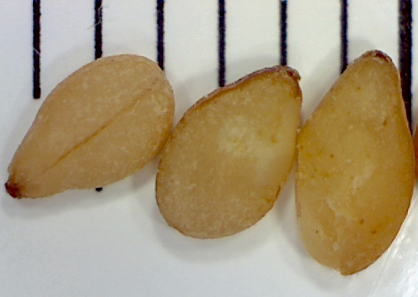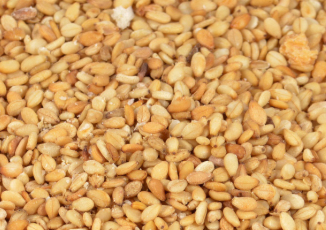| "Descrizione" by Ottika11 (2062 pt) | 2024-Jan-01 15:36 |
Review Consensus: 10 Rating: 10 Number of users: 1
| Evaluation | N. Experts | Evaluation | N. Experts |
|---|---|---|---|
| 1 | 6 | ||
| 2 | 7 | ||
| 3 | 8 | ||
| 4 | 9 | ||
| 5 | 10 |
Sesamum indicum (sesame) seed oil is an oil derived from the Sesame plant (Sesamum indicum L.), an oil crop with a high oil content. Sesame seeds contain 55-58% oil and almost 18% protein, lignans that enhance the antioxidant action of vitamin E, tocopherols and phenolic components.

In the production process, the seeds are ground and heated to a temperature of up to 90°C. The mince is boiled in water for a quarter of an hour and then cooled. After cooling, the top layer of oil is separated. 1 kg of seeds yields approximately 215 ml.
What it is used for and where

Medical
Sesame oil has the ability to inhibit the growth of the mycelial form of oral candidiasis or oral thrush (Candida albicans) caused by decreased saliva secretion especially in the elderly population (1).
Sesame oil is cheaper than chlorhexidine and can be used as a preventive home therapy to maintain oral hygiene by reducing colonies of aerobic microorganisms in dental plaque (2).
Cosmetics
Moisturising and conditioning agent for the skin.
Fragrance. It plays a decisive and important role in the formulation of cosmetic products as it provides the possibility of enhancing, masking or adding fragrance to the final product, increasing its marketability. The consumer always expects to find a pleasant or distinctive scent in a cosmetic product.
Hair conditioning agent. A significant number of ingredients with specific and targeted purposes may co-exist in hair shampoo formulations: cleansers, conditioners, thickeners, matting agents, sequestering agents, fragrances, preservatives, special additives. However, the indispensable ingredients are the cleansers and conditioners as they are necessary and sufficient for hair cleansing and manageability. The others act as commercial and non-essential auxiliaries such as: appearance, fragrance, colouring, etc. Hair conditioning agents have the task of increasing shine, manageability and volume, and reducing static electricity, especially after treatments such as colouring, ironing, waving, drying and brushing. They are, in practice, dispersants that may contain cationic surfactants, thickeners, emollients, polymers. The typology of hair conditioning agents includes: intensive conditioners, instant conditioners, thickening conditioners, drying conditioners. They can perform their task generally accompanied by other different ingredients.
Skin conditioning agent. It is the mainstay of topical skin treatment as it has the function of restoring, increasing or improving skin tolerance to external factors, including melanocyte tolerance. The most important function of the conditioning agent is to prevent skin dehydration, but the subject is rather complex and involves emollients and humectants that can be added in the formulation.
Skin conditioning agent - Emollient. Emollients have the characteristic of enhancing the skin barrier through a source of exogenous lipids that adhere to the skin, improving barrier properties by filling gaps in intercorneocyte clusters to improve hydration while protecting against inflammation. In practice, they have the ability to create a barrier that prevents transepidermal water loss. Emollients are described as degreasing or refreshing additives that improve the lipid content of the upper layers of the skin by preventing degreasing and drying of the skin. The problem with emollients is that many have a strong lipophilic character and are identified as occlusive ingredients; they are oily and fatty materials that remain on the skin surface and reduce transepidermal water loss. In cosmetics, emollients and moisturisers are often considered synonymous with humectants and occlusives.
Pharmaceuticals
Drug delivery vehicle
Other uses
Paints, insecticides
For more information:
Sesamum indicum seed oil, studies
References_____________________________________________________________________
(1) Ogawa T, Nishio J, Okada S. Effect of edible sesame oil on growth of clinical isolates of Candida albicans. Biol Res Nurs. 2014 Jul;16(3):335-43. doi: 10.1177/1099800413501539.
(2) Chandraprakash, R., Shivamurthy, R., Rangaraju, V. M., & Babu, H. M. Evaluation of Cocos nucifera and Sesamum indicum in comparison with Chlorhexidine on gingivitis-A double blind Clinico-Immunological study. International Journal of Ayurvedic Medicine, 12(3), 618-622.
Abstract. Background: Myriad of synthetic products has been used in chemical plaque control. There is a constant search for cost effective herbal products with minimal adverse effect to substitute synthetic compounds. The objective of this study was to evaluate the anti-inflammatory properties of Cocos nucifera and Sesamum indicum and compare their effect with commercially available chlorhexidine on gingivitis. Methods: In this double blind, randomized, control clinical trial, a total of 45 samples from patients aged between 18 to 35 years reporting to the institution, diagnosed with gingivitis were selected and randomly divided into Group-A (Scaling + Cocos Nuciferamouthwash), Group-B (Scaling + Sesamum Indicum mouthwash) and Group C (Scaling + Chlorhexidine mouthwash). Clinical (Plaque index, Gingival index and Sulcus bleeding index), and Immunological (Interleukin-6) parameters were assessed at baseline and 45th day following scaling. Saliva samples were collected and stored at -200C till they were subjected to enzyme-linked immunosorbent assay (ELISA) analysis. Inferential statistics done were analysis of variance, paired t test, post hock Scheffe test and Chi- square test by using SPSS software (22.0). Results: In Clinical parameters, group B (p˂0.001) showed statistical significant reduction compared to group A and group C. In Immunological parameter group A (p˂0.001) showed statistical significant reduction in Interleukin-6 compared to group B and group C (p=0.126 & p=0.196 respectively). Conclusion: Cocos nucifera and Sesamum indicum mouth washes effectively decreased plaque formation and could be used as an adjunct to scaling in treating plaque induced gingivitis.
Vadhana, V. C., Sharath, A., Geethapriya, P. R., & Vijayasankari, V. (2019). Effect of sesame oil, ozonated sesame oil, and chlorhexidine mouthwash on oral health status of adolescents: A randomized controlled pilot trial. Journal of Indian Society of Pedodontics and Preventive Dentistry, 37(4), 365-371.
Abstract. Context: Oil pulling procedure involves swishing of oil in the mouth for various oral health benefits. Aim: The aim of the study was to evaluate the effectiveness of sesame oil (SO), ozonated SO (OSO), and chlorhexidine (CHX) mouthwash on the oral health status of adolescents. Study Settings and Design: Parallel multi-arm double-blinded randomized trial was done in a Government higher secondary school. Materials and Methods: A total of 75 adolescents aged 12–14 years with decay-missing-filled index ≤3 were randomly assigned to three groups (n = 25): Group I (SO), Group II (OSO), and Group III (CHX mouthwash). Baseline (T1) Debris Index (DI-S), Calculus Index (CI-S), Oral Hygiene Index-Simplified (OHI-S), Plaque Index (PI), and salivary Streptococcus mutans count were recorded. All the groups were subjected to intervention with the respective mouth rinses for 15 days. The index scores and the salivary S. mutans count were reassessed after 15 days (T2) and 1 month (T3), and the results were statistically analyzed. Statistical Analysis: The statistical analysis was done using IBM SPSS Statistics for Windows. The statistical significance was set at P ≤ 0.05. Kolmogorov–Smirnov and Shapiro–Wilk test were used to test the normality of the data. The Friedman test and Wilcoxon-signed rank test were carried out for intragroup comparison. Kruskal–Wallis and Mann–Whitney U-test were employed to analyze inter-group comparison. Results: All the groups showed statistically significant reduction in DI-S, CI-S, OHI-S, PI, and S. mutans count after 15 days. Conclusion: Oil pulling therapy using SO and OSO showed a significant improvement in oral hygiene.
| Evaluate |

